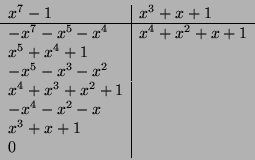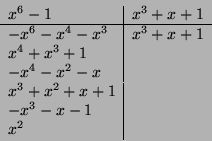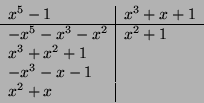In a single-variable polynomial ring ![]() whose coefficients are
elements of the finite field
whose coefficients are
elements of the finite field ![]() of size 2, an irreductible polynomial
of size 2, an irreductible polynomial
![]() of degree
of degree ![]() is said to be primitive it it divides
is said to be primitive it it divides ![]() for
for ![]() and it does not divide
and it does not divide ![]() for any
for any ![]() with
with
![]() .
.





We are asked to show that the minimum Hamming code is 3. What is the link
with the the above ring? We know that we can represent cyclic codes thank
to polynomials. ![]() will in fact be the set of our code words. It precisely
contains
will in fact be the set of our code words. It precisely
contains ![]() distinct polynomials. Because we want to achieve a code word
length of 7, we need a generator polynomial
distinct polynomials. Because we want to achieve a code word
length of 7, we need a generator polynomial ![]() and a message polynomial
and a message polynomial
![]() of the right length. Our cyclic code generator polynomial is
constructed from the factors of
of the right length. Our cyclic code generator polynomial is
constructed from the factors of ![]() . As
. As
![]() ,
,
![]() :
:

There, we notice that the minimum Hamming weight of the nonzero code words is 3, and therefore, this code has a minimum Hamming distance of 3.